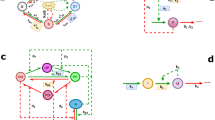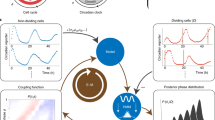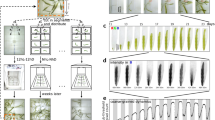Abstract
Circadian oscillators, which provide internal daily periodicity, are found in a variety of living organisms, including mammals, insects, plants, fungi and cyanobacteria1. Remarkably, these biochemical oscillators are resilient to external and internal modifications, such as temperature and cell division cycles. They have to be ‘fluctuation (noise) resistant’2 because relative fluctuations in the number of messenger RNA and protein molecules forming the intracellular oscillators are likely to be large. In multicellular organisms, the strong temporal stability of circadian clocks, despite molecular fluctuations, can easily be explained by intercellular interactions3,4,5. Here we study circadian rhythms and their stability in unicellular cyanobacteria Synechoccocus elongatus. Low-light-level microscopy has allowed us to measure gene expression under circadian control in single bacteria, showing that the circadian clock is indeed a property of individual cells. Our measurements show that the oscillators have a strong temporal stability with a correlation time of several months. In contrast to many circadian clocks in multicellular organisms, this stability seems to be ensured by the intracellular biochemical network, because the interactions between oscillators seem to be negligible.
This is a preview of subscription content, access via your institution
Access options
Subscribe to this journal
Receive 51 print issues and online access
$199.00 per year
only $3.90 per issue
Buy this article
- Purchase on Springer Link
- Instant access to full article PDF
Prices may be subject to local taxes which are calculated during checkout



Similar content being viewed by others
References
Young, M. W. & Kay, S. A. Time zones: a comparative genetics of circadian clocks. Nature Rev. Genet. 2, 702–715 (2001)
Barkai, N. & Leibler, S. Circadian clocks limited by noise. Nature 403, 267–268 (2000)
Pikovsky, A., Rosenblum, M. & Kurths, J. Synchronization: A Universal Concept in Nonlinear Sciences (Cambridge Univ. Press, Cambridge, 2001)
Liu, C., Weaver, D. R., Strogatz, S. H. & Reppert, S. M. Cellular construction of a circadian clock: period determination in the suprachiasmatic nuclei. Cell 91, 855–860 (1997)
Yamaguchi, S. et al. Synchronization of cellular clocks in the suprachiasmatic nucleus. Science 302, 1408–1412 (2003)
Kondo, T. et al. Circadian rhythms in prokaryotes: luciferase as a reporter of circadian gene expression in cyanobacteria. Proc. Natl Acad. Sci. USA 90, 5672–5676 (1993)
Liu, Y. et al. Circadian orchestration of gene expression in cyanobacteria. Genes Dev. 9, 1469–1478 (1995)
Katayama, M., Tsinoremas, N. F., Kondo, T. & Golden, S. S. cpmA, a gene involved in an output pathway of the cyanobacterial circadian system. J. Bacteriol. 181, 3516–3524 (1999)
Tsinoremas, N. F., Schaefer, M. R. & Golden, S. S. Blue and red light reversibly control psbA expression in the cyanobacterium Synechococcus sp. strain PCC 7942. J. Biol. Chem. 269, 16143–16147 (1994)
Kondo, T. et al. Circadian rhythms in rapidly dividing cyanobacteria. Science 275, 224–227 (1997)
Mori, T. & Johnson, C. H. Independence of circadian timing from cell division in cyanobacteria. J. Bacteriol. 183, 2439–2444 (2001)
Mori, T., Binder, B. & Johnson, C. H. Circadian gating of cell division in cyanobacteria growing with average doubling times of less than 24 hours. Proc. Natl Acad. Sci. USA 93, 10183–10188 (1996)
Gaspard, P. The correlation time of mesoscopic chemical clocks. J. Chem. Phys. 117, 8905–8916 (2002)
Elowitz, M. B., Levine, A. J., Siggia, E. D. & Swain, P. S. Stochastic gene expression in a single cell. Science 297, 1183–1186 (2002)
Kiss, I. Z., Zhai, Y. & Hudson, J. L. Emerging coherence in a population of chemical oscillators. Science 296, 1676–1678 (2002)
Levine, J. D., Funes, P., Dowse, H. B. & Hall, J. C. Resetting the circadian clock by social experience in Drosophila melanogaster. Science 298, 2010–2012 (2002)
Winfree, A. T. The Geometry of Biological Time, 2nd edn (Springer, New York, 2001)
Goldbeter, A. Computational approaches to cellular rhythms. Nature 420, 238–245 (2002)
Gonze, D., Halloy, J. & Goldbeter, A. Robustness of circadian rhythms with respect to molecular noise. Proc. Natl Acad. Sci. USA 99, 673–678 (2002)
Acknowledgements
We thank S. Golden for the AMC412 strain and for advice, D. Peoples for advice and technical assistance, B. Houchmandzadeh, J. Paulsson, J. Vilar, C. Weitz and M. Young for discussions, and N. Questembert-Balaban, E. Kussell and M. Vallade for comments on the manuscript. This work was supported partially by Princeton University through the Lewis Thomas Fellowship (I.M.), the National Institutes of Health, the Howard Hughes Medical Institute and the Centre National de Recherche Scientifique through an ATIP and an AC ‘Dynamique et réactivité des assemblages biologiques’.
Author information
Authors and Affiliations
Corresponding author
Ethics declarations
Competing interests
The authors declare that they have no competing financial interests.
Supplementary information
Supplementary Discussion
This has four sections containing discussions and Supplementary Figures S1 to S7. 1. Circadian oscillations of individual bacteria; 2. Estimation of the oscillator noise; 3. Extraction of the detection noise; 4. Detection limit of the coupling strength between oscillators. (PDF 1599 kb)
Rights and permissions
About this article
Cite this article
Mihalcescu, I., Hsing, W. & Leibler, S. Resilient circadian oscillator revealed in individual cyanobacteria. Nature 430, 81–85 (2004). https://doi.org/10.1038/nature02533
Received:
Accepted:
Issue Date:
DOI: https://doi.org/10.1038/nature02533
This article is cited by
-
Noise control and utility: From regulatory network to spatial patterning
Science China Mathematics (2020)
-
Circadian oscillator proteins across the kingdoms of life: structural aspects
BMC Biology (2019)
-
High protein copy number is required to suppress stochasticity in the cyanobacterial circadian clock
Nature Communications (2018)
-
Revealing circadian mechanisms of integration and resilience by visualizing clock proteins working in real time
Nature Communications (2018)
Comments
By submitting a comment you agree to abide by our Terms and Community Guidelines. If you find something abusive or that does not comply with our terms or guidelines please flag it as inappropriate.



